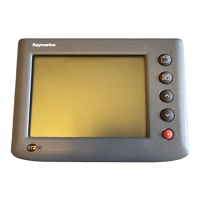6-2-2 Section 6: Installation
ST290 Instrument System Owner’s Handbook
2.2 Running SeaTalk & SeaTALK
2
cables
Cable routing practices
When running cable, always observe the following guidelines:
• If a cable has to be fed through the deck, always use a good quality
deck gland.
• Where cables are fed through holes, always use grommets to prevent
chafing.
• Secure long cable runs so they do not present a hazard.
• Wherever possible, route cables away from fluorescent lights,
engines and radio transmitting equipment, as these may cause inter-
ference.
• Always observe the SeaTALK
2
requirements, detailed in Section 6,
Chapter 1.
Identifying cables
SeaTalk and SeaTALK
2
buses are used in the ST290 system. SeaTalk
uses a 3-core cable and SeaTALK
2
uses a 5-core, screened cable. Each
cable type is available in both made-up form with pre-fitted connectors
(see Figure 2-1 ), and in unterminated form on a drum.
Figure 2-1: Bus connectors
If you are working with unterminated cable, use the details in Table 2-1
(SeaTalk) andTable 2-2 (SeaTALK
2
) to ascertain the correct
connections. Cable boots are available to cover the spade terminals used
to connect unterminated SeaTALK
2
cables. Further details are given
under Unterminated SeaTalk2 cable on on page 6-2-25.
D5786-1
SeaTalk connector
connector
SeaTALK
2
81183_2 S6.book Page 2 Wednesday, May 7, 2003 11:27 AM

